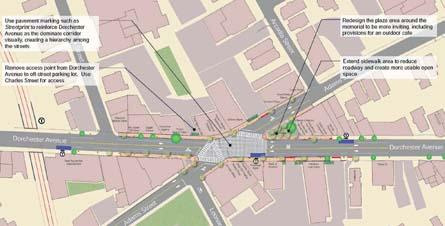December 8, 2011

How Fields Corner’s traffic flow has been altered. Critically, the city has eliminated a right-hand turn from Dot Ave. onto Adams St. Image courtesy BRA
Eighteen months and more than $14 million later, the massive project to renovate the intersections along Dorchester Avenue is nearly complete, but things are far from satisfactory, say residents who aired their traffic-driven grievances at a community meeting Tuesday night.
Boston Transportation Department senior planner Patrick Hoey reported that the project will see “pretty much 100 percent completion” once the spring construction season begins and the contractor finishes up the last plantings and other “punch list items.”
The meeting at the Vietnamese American Community Center on Charles Street was presided over by Fields Corner Main Street president Lee Adelson who said its purpose was to address some of the concerns that have arisen from the changes to local roadways and maybe offer some solutions.
Hoey encouraged residents to “fire away,” noting for the 20 or so residents at the session that as the project comes to a close in the Fields Corner area, drivers will see new paper markings for parking changes and the introduction of a new traffic signaling system that will synchronize the traffic flow of the entire Dot Ave. corridor and be monitored by staff in BTD’s headquarters. He assured the group that they will soon feel the difference the new signals will make to the traffic flow in the area.
Much of the feedback from the people in attendance stemmed from the loss of parking spaces near businesses along the avenue. In response, Hoey said, “Our intent was to minimize the loss of parking as much as we could,” adding that the plan found a good balance between the needs of parking, pedestrians, and traffic flow.
For solutions to the parking problem, Hoey suggested the community and city look at the possibility of installing parking meters along the avenue’s business districts. Although meters are typically only found downtown, he said, they could be used along the avenue if the neighborhood feels strongly about it. Meters, Hoey said, could encourage business customer parking and discourage abuse of the two-hour limit currently in use. Utilizing an off-street lot could also be a possibility, Hoey said.
Valerie Owen told Hoey the businesses operating in property she owns at the corner of Hancock Street and Dot Ave. have suffered due to the renovation. “Overall, I’ve lost nine tenets because of that project,” she said. Her complaints concerned the loss of parking spaces in front of and across the street from her building. When Hoey said the addition of a new plaza is good for business, Owen replied: “We don’t want that. We wanted the parking space, not the sidewalk space.”
John Walsh of Bowdoin Street said traffic delays in the area are “twice or three times as long as they used to be. They’re supposed to make it better, not make it worse,” he added.
Adelson disagreed, saying the changes have improved traffic. “I know the intersection of Glover’s Corner is better than it was two months ago when I was driving through it,” he said.
Several neighbors expressed frustration that they can no longer turn right onto Adams Street from the avenue. Hoey said the change was deliberate and will cut down on congestion resulting from conflicting traffic.
“What I’m hearing is it was intentional and it was over the concerns of the residents,” said one woman.
Hoey described the session as “a nice pleasant meeting,” regardless of the criticism. “It’s very difficult to strike that balance between public safety and convenience, or pedestrian accommodation and vehicular travel lanes, or parking, so it’s a difficult challenge. I think we found the right balance,” he said, adding that there is always room for improvement.
Work on the federally funded project began last spring under contractor McCourt Construction. The overhaul project has seen the installation of new curbs, drainage systems, wheelchair ramps and more where the avenue intersects major roads at busy spots like Peabody and Andrew squares. Additionlly, 11 minor intersections along the route were spruced up as the project moved along.
The American Recovery and Reinvestment Act, known as the stimulus bill, allowed the long-awaited project to move forward as the state took over construction from the city in order for the federal funds to be used.
The Massachusetts Department of Transportation provides details and updates on the construction at mass.gov/massdot/dotave.


